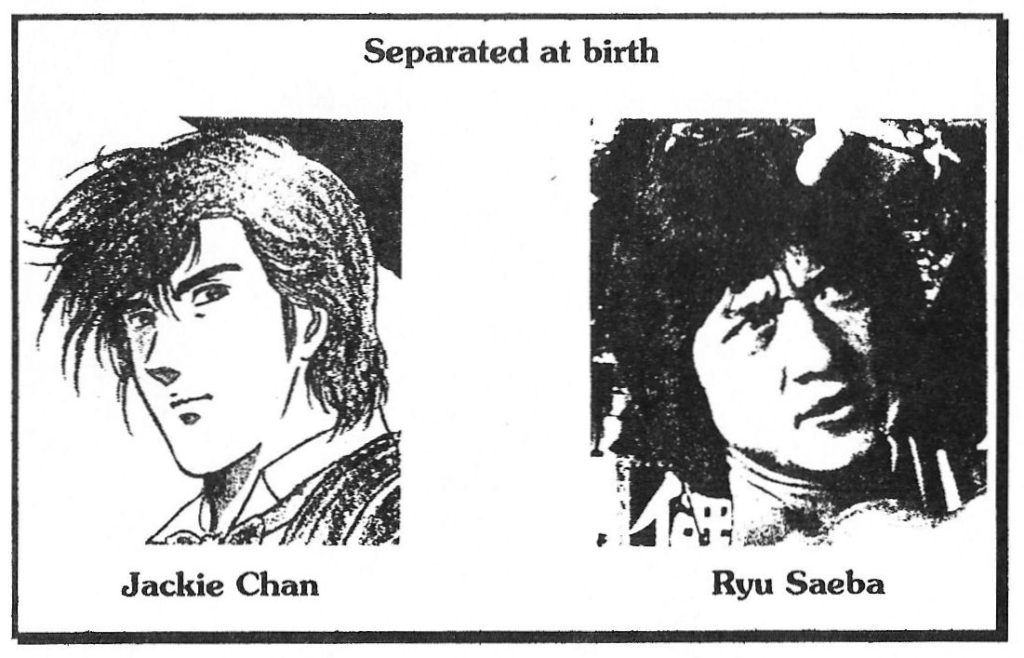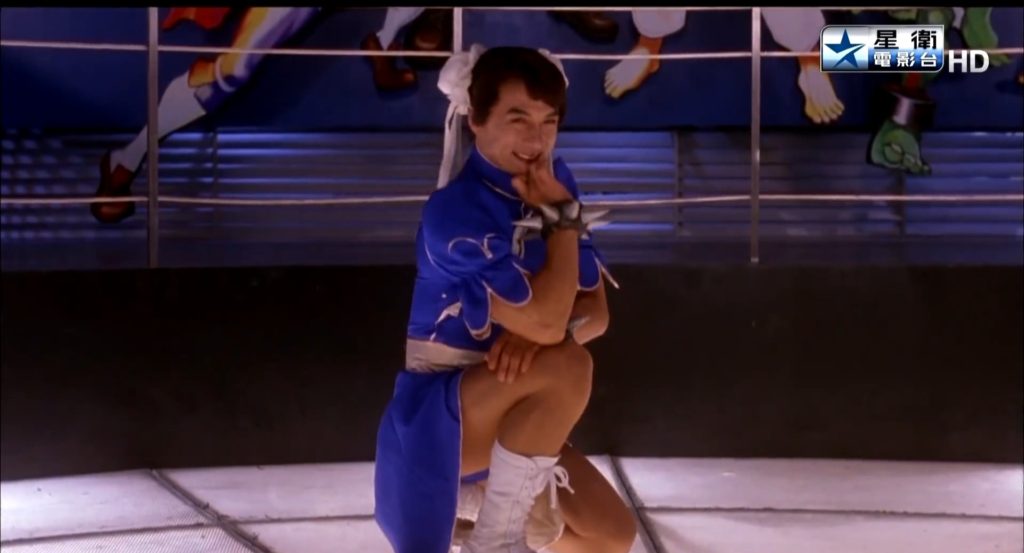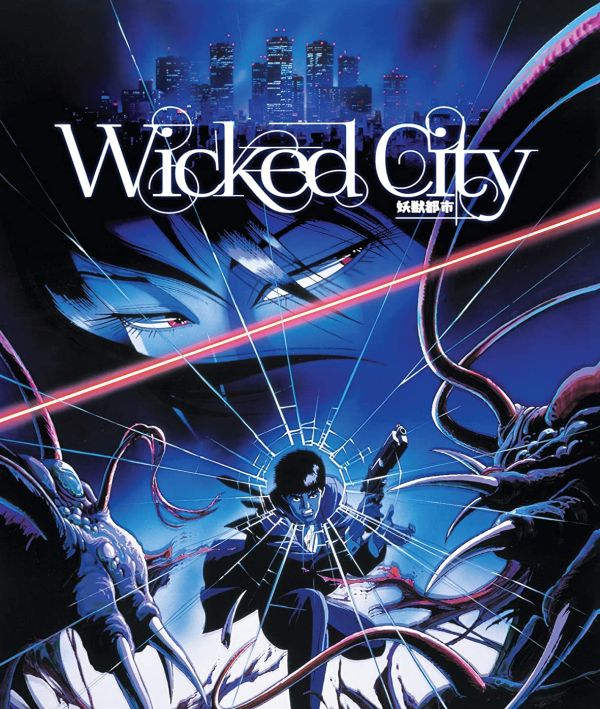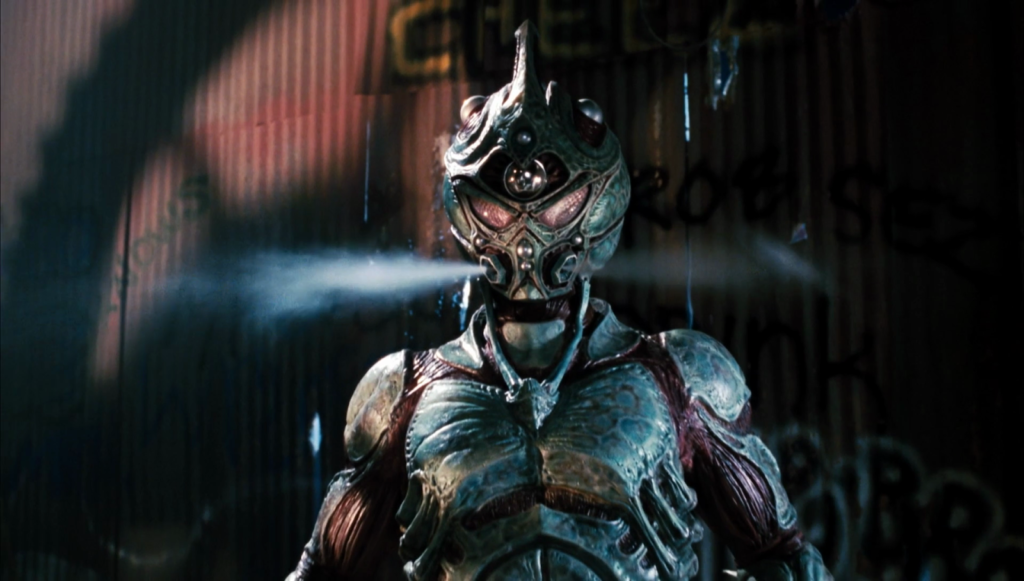Is it live, or is it anime?
In the same way cinema feeds off literature, anime feeds off manga. But recently, the process has been taken further, with the appearance of live-action films, official and otherwise, which take inspiration to a degree from Japanese animation. Here are some comparative reviews of the most striking examples, which should keep you going until the proposed live-action version of ‘Fist of the North Star’ appears, with Gary Daniels as the, er, Northern star of the fists.

The Magnum of Love’s Destiny vs. City Hunter
City Hunter’s adaptation was not really a surprise, as it’s a phenomenally popular series. Hero Ryu Saeba was second in a Japanese poll for All-Time Favourite Anime Character, and it’s also the No.1 comic in both Hong Kong and Taiwan. But we can’t directly compare live-action and anime versions because here only the characters are borrowed. Plotwise, the animated City Hunter movie, “The Magnum of Love’s Destiny”, bears absolutely no resemblance to Jackie Chan’s film. And indeed, JC himself is very different to the “real” Ryu Saeba, who is over six feet tall, revels in lechery (in the manga, his erections break bullet proof glass and calls himself “the #1 pervert in Japan”) and wields a Colt Python .357 Magnum. Jackie isn’t, doesn’t and doesn’t, respectively. But Jackie’s reworking retains the same outlook – humour ‘n’ violence – and is great fun, even if you’ve never seen the anime.
The plot is easy to dispose of: “Die Hard” on a boat, aka “Under Siege”. Ryu & sidekick Kaori are on a liner, hunting a tycoon’s daughter. Also there are jewel thieves, two beweaponed police-babes, a hypernatural gambler and a lot of hostages. Work out the rest yourself.
While the story is basic, execution is impeccable. JC’s last couple have been disappointing, but this is a cracker. Physical comedy is his forte: he delivers hideous amounts of ultra-violence yet, as in the best cartoons, pain is merely a punchline. Once the thieves take over the ship, it’s non-stop action to rival ‘Police Story’, tho’ with surprisingly little martial arts. However, the best scene has to be the one where our hero gets electrocuted by a ‘Streetfighter 2’ machine, and transforms into the characters from it, including Chun-Li who finishes off villain Gary Daniels with a gleeful “Ya-taaa!”.
If there is a weakness in this film, I can’t see it; it gives you everything you could want from an action movie and then some. There’s another film out called ‘Lady City Hunter’, starring TC-fave Cynthia Khan. Despite her extra cute, it’ll have to be seriously good to match this effort. A

Having examined the live-action film in isolation, what’s “Magnum…” like on it’s own merits? Firstly, it assumes the viewer knows the background, understandable, given the TV series has 100+ episodes. Newcomers may hence be forgiven for wondering about the massive hammers with which Kaori frequently clubs Ryu on the head (usually after an especially debauched letch!).
Its plot is incredibly complex, at least in comparison to JC’s film, and is more of a thriller than an action movie, with secret agents, diplomats, double-crosses and people-not-being-what-they-seem. As such, it seems a waste of time animating it. as there’s little that couldn’t be done with actors. The aforementioned hammer is one of the few additions, and most of the film’s memorable sequences happen as Ryu Saeba tries to get off with one or other of the pretty women who cross his path.
It’s enjoyable enough on it’s own terms, skillfully animated and with excellent story-handling; but anyone coming to this via the Jackie Chan movie will probably be disappointed, just as any anime fan drawn to the live-action version will have been in for a surprise. C
Supernatural Beast City vs. Wicked City
Supernatural Beast City is one of the most rampantly enjoyable of the horror anime films, mixing sex with large helpings of messy violence, and topping the cake with slabs of style. There is also an wry sense of humour, presumably intentional – lines like “It’s alright, he only got my false arm” are hard to take seriously. The tone is set with a real zapper of an opening scene: the hero, Taki, picks up a woman in a bar and takes her to his hotel. After sex, she metamorphoses into a spider-creature with a vagina dentata, and scurries down the hotel wall, leaving Taki grateful to still have his tackle intact.
The plot is then revealed; the two worlds, demon and human, are to sign a peace treaty. However, some sections of the demon world are opposed to this and are trying to wreck the treaty. Taki, together with a female demon whose fngernails make Freddy Krueger look like a blunt letter-opener, are assigned to bodyguard one of the signatories, and have to fend off a near-continuous series of attacks. Things are not quite as obvious as they seem, however, and by the end, very little of what you thought was true turns out to be accurate.
The animation is excellent, and makes full use of all the tricks at it’s disposal to enhance the action. The plot does have holes – the VIP starts off in a hotel, before moving to a more secure location, begging the question why he didn’t go there to start with – but these can be ignored. A personal favourite, it’s “Evil Dead”s ‘spam in a cabin’ upped to “spam in a megalopolis”. A-
[The dubbed version (Manga, 12.99), known as ‘Wicked City’ is pretty good, though the irony appears to have gone AWOL, leaving some dialogue seeming merely squirm-inducingly shabby; real pedants may quibble over the change in the pronounciation of the hero’s name from ‘Tah-ki’ to ‘Tacky’ (though ‘tacky’ seems entirely appropriate to me!). But it’s otherwise nicely done – it’d take a lot to sink this one – and is still unquestionably worth picking up. B+]

The similarities of `Wicked City’ to SBC start with the title, which matches the one by which SBC is known here. And the opening scene, too, is an obvious lift, with Taki taking a woman to his room, etc. Things do diverge, as he is saved by his colleague, Ken, and from there on the stories follow parallel but differing courses. In both, there are friendly female ‘raptors’, as ‘Wicked City’ calls them (shades of ‘Jurassic Park’ perhaps?), and the demon world is divided against itself. However, ‘Wicked City’ concentates more on the power struggle between the raptor leader, Daishu, and his son who wishes to poison the human world with a drug called ‘happiness’.
The raptors are also more variable; in SBC, they’re either human or, well, icky, but ‘Wicked City’ has a wild assortment of different species. Most notable are the liquid kind (with very nasty effects if you drink one – think ‘Scanners’) and a pseudo-cybernetic creature capable of becoming anything from an elevator to a nymphomaniac pinball table. Indeed, under duress, she turns into a femme-bike: this would seem to be based on anime/manga “Midnight Eye”, and it is known that producer Tsui Hark has been working with it’s creator, Byuichi Terasawa.
While full of great ideas, ‘Wicked City’ doesn’t quite live up to some of them. It’s almost as if the makers threw in everything they came up with, regardless of successful execution. Characters, and indeed the acting, seem something of an afterthought. The end result is something that does pass muster, especially at the cinema where the visuals are especially striking. but on close inspection it shows definite signs of urban decay. C+
The Guyver vs. Mutronics
What is it about Japanese schools? Watching anime, you get the impression that educational establishments there are multicultural in a way undreamt of by even the looniest local council; the average school has aliens, trans-sexuals, demons, lechers and, in `The Guyver’, even the odd piece of military bio-technology. It’s probably the case that after graduating, all of the above settle down, get steady jobs as salarymen, marry, have kids, and become pretty boring. “Legend of the OverAccountant”, anyone?
Anyway, the basic premise here is as follows: a “thing” is taken out of a top-secret laboratory and attaches itself to an unsuspecting hero. Then, said hero transforms at irregular intervals into a monster, capable of taking on a selection of other monsters sent out from the top-secret lab to retrieve “thing”. Repeat as necessary.
The result is enjoyable schlock in 25-minute doses, but it doesn’t take long – two episodes are enough – to spot the pattern and make a reasonable guess as to what will happen in the future. To steal a (mis)quote, “imagine a monstrous foot stomping on a monstrous face…forever”. Of course, I could be wide of the mark. Maybe the Guyver finds a cute female monster, falls in love, moves to a suburb of Osaka and gets a job as an estate agent. But I don’t think so. D- [However, there is a different animation, ‘The Guyver: Out of Control’, which tells pretty much the same story, just rather better. It gets a B- and is thus definitely preferred]

Hollywood is littered with the corpses of comic-book characters which failed to one degree or other – Supergirl, Swamp Thing and, probably the biggest turkey a l’orange of them all, Howard the Duck. ‘Mutronics’, as the live-action ‘Guyver’ was called in this country, is the first anime/manga to be filmed in the West; presumably, the film received a certain impetus from the Japanese origins of director Screaming Mad George. And it isn’t in the same league as the abovementioned failures, perhaps because it’s relentless stupidity is deliberate, and in fact, quite endearing.
The core story remains the same, albeit moved out of school, and there’s a love interest. The attitude is also seriously changed, with a large number of horror in-jokes, courtesy of people like Linnea Quigley and Jeffrey Coombs; the planned sequel is going to be darker and less humourous. While it loses on the effects side – there are too many rubber suits and off-camera transformations – it gains by being a complete story, rather than having to cram in some story, advert breaks and a climax into thirty minutes. The overall effect is more reminiscent of Japanese live-action shows like ‘Kamen Rider’ than any anime, with people in strange costumes hurling each other around like rag dolls.
Overall, if you’re a fan of monster movies and horror films, then it will probably work. But if you’re not, then it may be just a little too silly to get a grip on. Fortunately, I fall into the former category and, as far as Americanised anime go, it’s a lot better than ‘Battle of the Planets’. B-
The best of the rest
This merely represents the thin end of the wedge, and are those you’ve the best chance of seeing. Also worth noting are ‘The Story of Ricky’, a splatter-fu live-action version of ‘Riki-oh’, with some truly special effects on the gore front, and ‘Killer’s Romance’, inspired by (ok, ripped off from) ‘Crying Freeman’. There’s also an official live-action ‘Crying Freeman’ under production in America, produced by Brian Yuzna. And the Japanese have, at various points, turned the following anime series into live movies, or vice versa: Lupin III, Appleseed, Doomed Megalopolis, Maison Ikkoku, Kekko Kamen, Yawara!, Dragonball Z (due for release here in ’94), Sukeban Deka, Kimagure Orange Road and Video Girl Ai. We await a remake of ‘Legend of the Overfiend’ with interest…